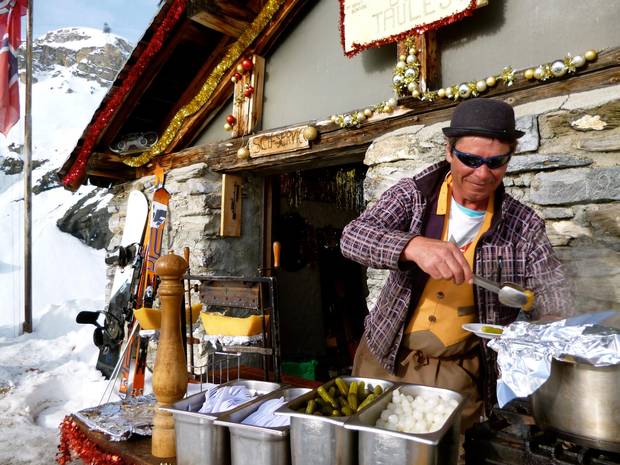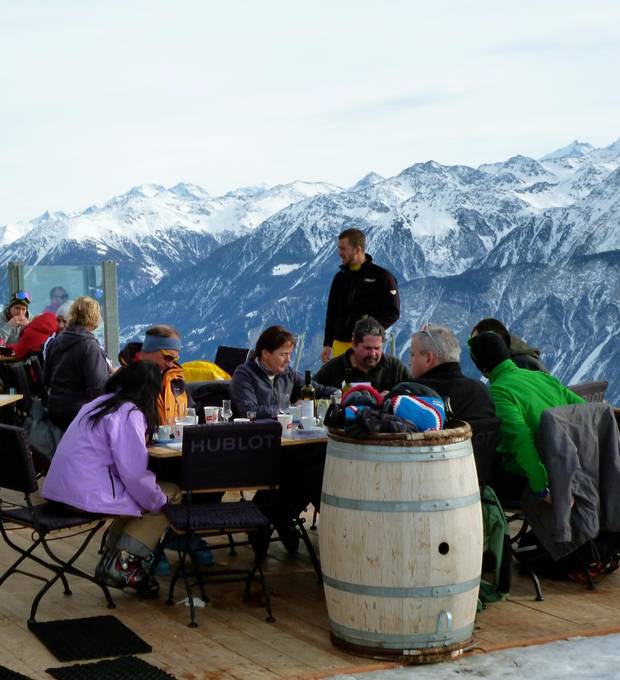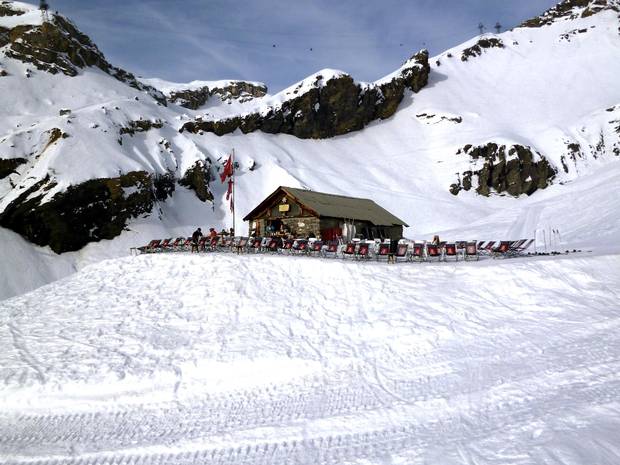We stood perched on our skis, 2,700 metres above sea level, overlooking the glacier of the Plaine Morte, or the dead plain. It was a gloriously sunny morning in early January and you could see clear across to snowy Mont Blanc, the Matterhorn and Italy beyond, and down to the Rhône Valley below to the small city of Sierre, where I had taken the funicular past steeply sloping vineyards to the ski resort of Crans-Montana. Valentin and Nadège, my Swiss guides, pulled me out of my reverie. "Let's go," Nadège said. "We'll be late for lunch. We have a 12 o'clock reservation."
A reservation? For a hut? This might seem unusual to Canadians more accustomed to long queues and unfortunate ski-chalet lunches of stale pizza and soggy poutine. Yet, from homemade pasta in the Dolomites to farmhouse cheeses in the Haute Savoie to fine wines in Switzerland's Valais region, haute cuisine in high altitude huts is becoming increasingly common in the Alps.
This was certainly the case in Crans-Montana, where I spent a few days skiing last winter.
The neighbouring villages of Crans and Montana, now merged into one town, are set on a south-facing plateau 1,500 metres above sea level. Home to Sir Roger Moore, the resort offers 140 kilometres of excellent ski pistes, predominantly for intermediate skiers. While not as charming or characterful as other Swiss alpine towns such as Muerren or Champéry, Crans-Montana makes up for what it lacks in coziness with its award-winning and Michelin-starred restaurants and high-end fashion boutiques.
Despite its good selection of restaurants, Crans-Montana's real gastronomic action, in winter, often occurs not in town but high up the slopes in rustic ski and hiking chalets, former gondola stations and even in cow milking barns.
For skiing and snowboarding gourmands, the most appealing feature of these eateries is that you can ski right up to the front door.

Thomas, manager of Cabane des Taules, prepares raclette outside a bare-bones shed; it’s a popular location even without a formal patio.
Photos by Elizabeth Warkentin
After leaving the glacier behind and skiing over feathery white snow, we arrived at Cabane des violettes, a rustic stone hut with red and white shutters that is part of the Swiss Alpine Club's network of huts. Seated on the gigantic south-facing veranda overlooking jagged snowy peaks, I tucked into the couloir marinelli, a flavourful tomato, garlic and parsley penne dish.
Valentin had the more traditional three-tiered croûte au fromage, while Nadège ordered the Gruyère gnocchi.
Everything we ate was fresh, house-made and prepared with care under the direction of Michelin-starred chef Franck Renaud. Later, as I dipped my spoon into my artfully arranged dessert, a layered concoction in a glass involving a Bartlett pear, a gingerbread cookie and vanilla yogurt, I wondered aloud: How can the food be this good, this high up?
"The skiing mentality has changed," Nadège said. "People want to ski, but they also want to take the time to relax, eat well, take the sun. Before, eating on the pistes was all about refuelling and getting back out there. People would eat mediocre spaghetti Bolognese or sausages and fries. Now they want to eat ecologically, taste the bounty of the terroir."
The following day, after skiing a few hours around the Cry d'Err and the lunar landscape of the Plaine Morte, Valentin and I stopped for lunch at Le Chetzeron, a boxy restaurant and hotel built in an old cable terminal. The restaurant has been in operation a few years now, but the hotel had its launch only in summer, 2014. With sunken fire pits on its capacious three-level deck, angular leather sofas, cowhide armchairs, concrete walls and panoramic windows, Le Chetzeron's sleek design ambiance couldn't be further removed from the old-school rusticity of La Cabane des violettes.
With a focus on seasonal, local ingredients, the restaurant serves "refined Alpine" cuisine, several of the dishes baked in a wood-fired oven. I ordered the polenta and vegetable casserole, which arrived in a still-sizzling, individually sized cast-iron pot. While I don't normally drink when I ski, I decided to try a glass of one of the Valais wines, a Fendant blanc, that I'd been hearing so much about since I'd arrived. Only 1 per cent to 2 per cent of Swiss wines are exported, but the country's vintages are well-regarded among the global wine connoisseur set. Francophone Valaisians, in particular, tend to be proud of their wines. And rightly so. The Rhône River Valley is Switzerland's largest and oldest wine-producing region, with some estates dating back to Roman times.
On my last full day in Crans-Montana I skied with Valentin again. While riding on the Toula lift for a final run of the day, I noticed a little shed below, where a lot of people were gathered. "That's the Cabane des Taules," said Valentin. "The farmer takes his cows to graze up here in the summer during the alpage season. In winter there's a guy who uses it to serve raclette and cakes." Did I want to go, he asked. Of course I did.
Plastic glass of Apfelschorle, a popular drink of carbonated mineral water and apple juice, in one hand, and a slice of homemade plum tart in the other, I observed the scene. This was indeed a shed. There were no tables inside. In fact, customers didn't enter except to order goulash or polenta. Outside there was no real patio, only plastic tables and chairs laid out flat on the slope. Thomas, the affable manager who sports a bowler hat and vests in bright primary colours, mans the raclette contraption. With no regular kitchen facilities, Thomas and his young assistant, Pierrot, keep the selection simple: raclette, cheese or polenta goulash, juices, Valaisian wine and freshly baked homemade fruit tarts. Everything is transported by snowmobile. The shed is so popular that on Dec. 29 last year, they served 600 dessert-size plastic plates of raclette and eight 11-by-14-inch pans of fruit tart. " Ils nous ont dévalisés," Pierrot said. "They cleaned us out."
Belly full, my legs stiff as lead, I feigned skiing as best as possible – bend knees, rise up, glide and turn, tumble – as we made our way back to the village. As the sun began to set, painting the majestic peaks pink and orange, I marvelled at what a beautiful – and delicious – ski holiday it had been.

The terrace at Cabane des violettes, below, has spectacular views.
Elizabeth Warkentin
IF YOU GO
The closest international airport to Crans-Montana is Geneva (180 kilometres). From Geneva you can rent a car for the two-hour drive or hop on the train (sbb.ch) for the scenic journey to Sierre, where you'll board a funicular to Montana Gare for the approximately 20-minute climb.
Where to stay
The 60-room Crans Ambassador Luxury Sport Resort: The sleek hotel is distinguished by its modern design using local materials. Prices in January start at 400 Swiss francs ($520) for a double room, with breakfast. cransambassador.ch
Hostellerie du Pas de l'Ours: This luxury mountain chalet offers a wide range of options from double rooms to three-bedroom chalet suites. Prices in mid-December range from 400 Swiss francs to 2,500 Swiss francs. pasdelours.ch
Aux Bons Matins de Capella: Located in the village of Chermignon, six kilometres from Crans-Montana, this cheerful bed and breakfast in a traditional Swiss chalet has double rooms starting at 229 Swiss francs a night, including breakfast. abmc.ch
Where to eat
Le Chetzeron: Prices here are steep, but the views alone might be worth it. The restaurant serves a variety of polenta dishes, salads and charcuterie plates. chetzeron.ch
Cabane des violettes: In winter, chef Franck Reynaud specializes in hearty Valaisian fare such as cheese fondue, potato rôsti and croûtes au fromage. cabanedesviolettes.ch
Cabane des Taules: Located at 2,000 metres on the Toula run, Cabane des Taules serves simple local fare: raclette, cheese or polenta goulash, wine and homemade fruit tarts.
The writer travelled as a guest of Switzerland Tourism. It did not review or approve this article.
